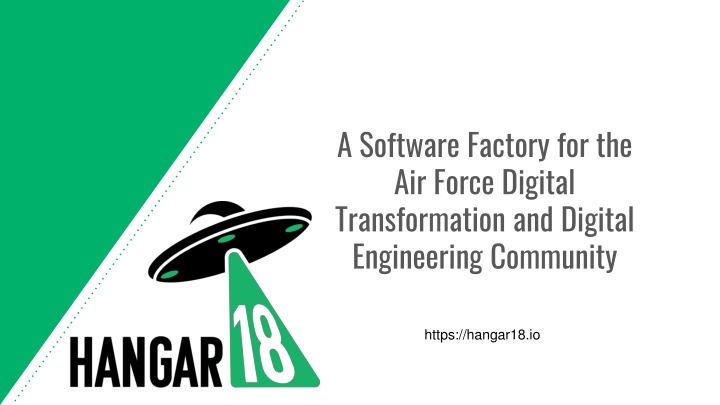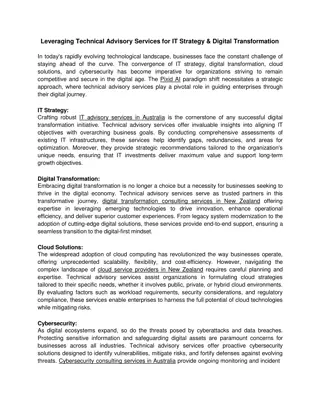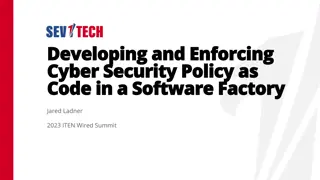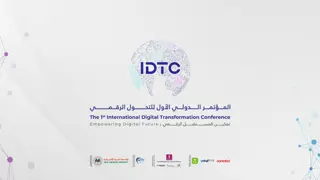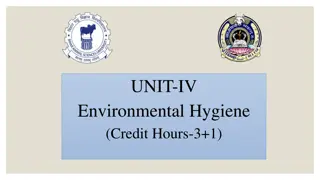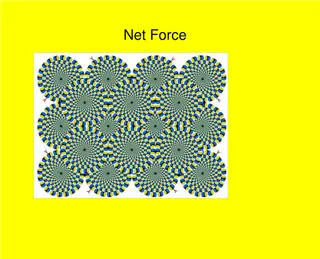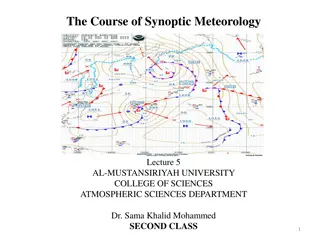A Software Factory for Air Force Digital Transformation
Hangar 18 is a collaborative initiative at WPAFB aiming to create a software factory for the Air Force digital engineering community. The project involves building key software and data capabilities for digital transformation and beyond, with a focus on Agile, DevSecOps, and education. Motivated by the surge in digital transformation demand, the project is supported by partners AFRL/RX and AFIT, leveraging historical projects with strong digital engineering backgrounds. The goal is to deliver value through cost savings, decreased technical risks, and efficient software deployment.
Download Presentation

Please find below an Image/Link to download the presentation.
The content on the website is provided AS IS for your information and personal use only. It may not be sold, licensed, or shared on other websites without obtaining consent from the author.If you encounter any issues during the download, it is possible that the publisher has removed the file from their server.
You are allowed to download the files provided on this website for personal or commercial use, subject to the condition that they are used lawfully. All files are the property of their respective owners.
The content on the website is provided AS IS for your information and personal use only. It may not be sold, licensed, or shared on other websites without obtaining consent from the author.
E N D
Presentation Transcript
A Software Factory for the Air Force Digital Transformation and Digital Engineering Community https://hangar18.io
Contents Hangar 18 Overview Motivations and Value Proposition Factory Structure & Roadmap Portfolio Review BLUF: Creating a software factory at WPAFB was a timely, low-risk investment that is delivering key software and data capabilities to the digital engineering community and beyond. 2
Background Early 2021 -discussions within WPAFB software community showed strong interest in a larger cross-org collaboration model for a new software factor AFRL/RX and AFIT CyTCoE stepped forward as partners for new venture Objective: take 12 months to build a Software Factory and deliver value Pathfinder Project: OBSS (AFRL attritables effort) chosen as the main DE pathfinder for Hangar 18 Committed to start small, learn fast approach 3
Hangar 18 - What is it? A federation of digital teams and assets at WPAFB which are coordinated through a nexus, initially founded by AFRL/RX and AFIT. Mission Delivering Deliver Agile and DevSecOps to the Digital Engineering and Digital Transformation community. Cost and time savings for prototyping and deploying software Education hub for Agile, DevSecOps, and data practice Advocacy, Training and Leadership for UI/UX, development, test, etc. Increased awareness and communication Deploy tools and tool pipelines (we build it for you) Guide technical efforts (we help you build it) Educating the workforce 4
Why are we doing it? Motivations: Demand:widespread surge in DA/DE and Digital Transformation (DT) Supply:HyperThought and Avolve teams well-suited to lead in propagation and integration of digital tools and processes Hub is needed for educating, advocating, and awareness Historical projects (LCAAPS, PiCARD) with strong DE background Inspirations: Behind the Curve: 16 other factories launched and running successfully Willing coalition (AFRL/RX, AFIT) with production-ready products (RX- HyperThought, AFIT-Avolve) Digital Engineering practice strongly dependent on Agile, DevSecOps, and other Software Engineering(SE) tenets 5
The Value of Hangar 18 Propagate tools, methods, and education Rapid decrease in technical risk and schedule delays Cost savings on the systems development lifecycle Integrate (not duplicate) existing SE/DE capabilities and processes Center of Gravity for SE and DE practice in WPAFB community Maximize DE and DT AFIT resources on AFRL projects 01 Agile, Scalable Software Factory 03 02 Lorem ipsum 1.https://www.gao.gov/assets/gao-21-182.pdf 2.https://media.defense.gov/2019/Mar/26/2002105909/-1/-1/0/SWAP.REPORT_MAIN.BODY.3.21.19.PDF 3. https://www.airforcemag.com/article/the-air-force-software-revolution/ 6
Core Strengths and Capabilities Immediate synergy of cross- org competencies, focused on high value, common problem areas. Data Visualization and Analytics Process Modeling and Workflow Knowledge and Data Modeling One-stop shopping for: User-Centered Design Software/data engineering capabilities DevSecOps Pipelines Rapid Cloud Deployments (Platform One, AWS, Azure, Google Cloud) Formal and Informal Education and Training -DE, SE, Agile, etc. Digital Engineering Foundations 7
Functions Outreach Education DevSecOps Formal training/certifications Deploying software for key mission/ capability areas on AF Networks Promote DoD DevSecOps in the region Maintain internal DevSecOps team delivering continuous product Assemble/coordinate project teams for external projects Concept training, P1 liaison, onboarding assistance Public/DOD -AFA Dayton, Air Force Magazine, Dayton Dev Coalition, LinkedIn, etc. WPAFB -Ask Me Anything, Hackathons, DevSecOps CoP/CoI/CoC Multi-day courses @ AFIT -Agile, DevSecOps, CI/CD, Cloud, TDD, UI/UX Agile/DevSecOps for internal consumers DevSecOps Explorers -residencies for external consumers 8
Community Structure A tiered structure allows Hangar 18 to stay connected with key parts of the broader organization without requiring extensive commitment: Core - develops and propagates tools, teams, and educational materials. Works directly with IT and DE stakeholders to guide efforts to success. Active Collaboration - funnel for project ideas, advocates and provides input for H18 resources Community of Interest - consumes and propagates best practices, participates in outreach activities Community of Interest: AFRL/RQ, AFSC Active Collaboration: NASIC, LCMC Hangar 18 Core: AFRL/RX, AFIT, AFRL/RY Multiple layers of investment 9
Organizational Structure Director/CTO: Matthew Jacobsen (AFRL/RXMD) Senior Advisor: Col Blair Watkinson (AFRL/RYZ) Chief of Outreach and Education: Chief of Education and Training: Liaison to AFIT/EN: Dr. Mark Reith Matthew Dever (AFIT CyTCoE) Richard Sugarman (AFIT/LS) Educational Materials Marketing Communication Courses Workshops Certifications 10
Introducing Agile and DevSecOps to DE Digital (not digitized) Eng demands integration across the lifecycle Dig Eng (or any part of the lifecycle) is heavily software and data dependent Failure modes are almost identical Agile roles apply to both software and data efforts (ex. product owner) Short iterations offer the same benefits in software and data Data security and infrastructure require the same attention DevSecOps tools and practices (linting, scanning, etc) are critical to success in data All software tooling in DE should follow Agile and DevSecOps principles Data/Model Iteration Working software is the primary measure of progress Becomes Working software and data are the primary measures of progress 11
Use Case #1 - Digital Transformation Question/Problem: laboratory environments need dedicated, enterprise support to implement digital tools and processes to meet DT objectives. Specific pain points: 1. 2. 3. 4. Uncertainty on specific skill sets No plan for coordinating resources and prioritizing work Lack of awareness of system integration demands Lack of appropriate contract vehicles Answer: DT leads engage Hangar 18 to facilitate onboarding of new resources. 1. 2. 3. Expansive talent pool to draw from, numerous contract vehicles to use Resources trained and integrated according to Agile and DevSecOps practice IT architecture and fielding plans developed per AF standards 12
Use Case #2 - Digital Engineering Question/Problem: Stakeholder demand for DE practice, including better quality TDPs, and the use of techniques such as MBSE 1. 2. 3. 4. Lack of awareness on DE fundamentals No clear path to an Integrated Digital Engineering Environment Not sure how to craft contract language for deliverables No awareness of how to validate fidelity and suitability of of contract data payloads Answer: Stakeholders engage Hangar 18 to drive DE practice at the project level 1. 2. 3. 4. Experience in Dig Twin activities and Dig Thread interconnects Deep pool of education and training content available Demonstrated value on vanguard programs H18 coordination with broader AFRL DE functions 13
Use Case #3 - Software Engineering Question/Problem: Demand and funding exist for software in S&T community, but SE focal point and leadership are lacking 1. 2. 3. 4. Expertise in process and data, but not in forming, validating, and testing requirements Separation of responsibilities -process owner should not drive SE effort S&T community not trained in design, development, and deployment/fielding, esp using Agile 90% documented failure rate for software due to lack of proper, modern SE practice Answer: Hangar 18 serves as Product Owner and Agile Coach for S&T members 1. 2. 3. 4. Long history of Agile and DevSecOps on both teams Extensive training available through AFIT/LS and hands-on H18 workshops Significant experience in cybersecurity planning, fielding and deployment, including Cloud Hangar 18 doesn t develop, it guides and teaches 14
Use Case #4 - AFIT Student Engagement Question/Problem: How can we maximize the involvement of AFIT resources to quickly show value on AFRL projects? 1. 2. 3. How can we enhance the pipeline for getting AFRL project ideas into graduate programs? Costly to on-board traditional resources for research in DE use cases on AFRL projects Disconnect between education, training, and application/experience Answer: Hangar 18 connects AFRL DE demand signals with graduate projects 1. 2. 3. 4. Cost-effective, reduced risk Rapid turn-around (12-18 months) Mutually beneficial Career pathways from AFIT to AFRL 15
Use Case #5 - DE/Software Org Communication Question/Problem: Pockets of innovation and development DE/SE emerging in the community, but without coordination or communication (each TD, etc. has a center for DE/DT, etc.) 1. 2. 3. Inconsistent application of Agile, DevSecOps, and DE principles Massive redundancy -each org responsible for green field solution space Varied and costly technology investments, causing delays and budget overruns Answer: Hangar 18 serves as hub for communication and facilitation 1. 2. 3. Promotes awareness of key initiatives and re-use of technologies and methods Offers education and training in SE/DE areas Provides avenues for development and deployment within innovation pockets 16
DevSecOps A cultural shift that breaks down traditional walls between functional components Promotes the growth of versatilist practitioners: Support different aspects of the DevSecOps lifecycle (see image 1 below) All share in the project outcomes Incentivizes collaboration and communication Supported by the use of Continuous Integration/Continuous Delivery (CI/CD) tools Accelerated by the use of cloud environments such as P1/C1, where all phases and functions of the SDLC can be integrated 17
Agile A framework that breaks the developmental process into iterative steps, allowing for flexibility, testing, and change throughout the lifecycle of the project Teams complete work in sprints, which are typically broken out into two-week chunks of time. Various checkpoints throughout the project allow the team to change direction as needed. Delivery of initial capabilities is rapidly increased, which has several implications: Project risk is reduced vs the Waterfall method Tighter integration of lifecycle components Higher quality product delivered in less time, at less cost. 18
